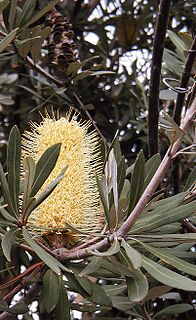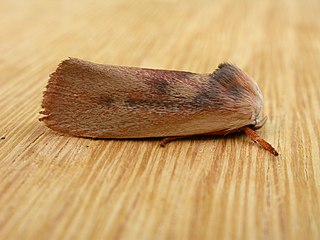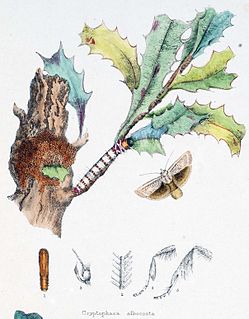| Cryptophasa flavolineata | |
|---|---|
| Scientific classification | |
| Kingdom: | Animalia |
| Phylum: | Arthropoda |
| Class: | Insecta |
| Order: | Lepidoptera |
| Family: | Xyloryctidae |
| Genus: | Cryptophasa |
| Species: | C. flavolineata |
| Binomial name | |
| Cryptophasa flavolineata (Walker, 1864) | |
| Synonyms | |
| |
Cryptophasa flavolineata is a moth in the family Xyloryctidae. It was described by Francis Walker in 1864. It is found in Papua New Guinea and Australia, [1] where it has been recorded from New South Wales and Queensland.

Moths comprise a group of insects related to butterflies, belonging to the order Lepidoptera. Most lepidopterans are moths, and there are thought to be approximately 160,000 species of moth, many of which have yet to be described. Most species of moth are nocturnal, but there are also crepuscular and diurnal species.

Xyloryctidae is a family of moths contained within the superfamily Gelechioidea described by Edward Meyrick in 1890. Most genera are found in the Indo-Australian region. While many of these moths are tiny, some members of the family grow to a wingspan of up to 66 mm, making them giants among the micromoths.

Francis Walker was an English entomologist. He was one of the most prolific authors in entomology, and stirred controversy during his later life as his publications resulted in a huge number of junior synonyms.
The wingspan is about 50 mm. The forewings are snow white with a faint pale yellowish central longitudinal line from before the middle of the disc almost to the hind margin. There is a suffused ochreous-yellow line along the submedian fold from the base to the anal angle and a short slender ochreous-yellow streak along the inner margin about one-third. The hindwings are snow white.

The wingspan of a bird or an airplane is the distance from one wingtip to the other wingtip. For example, the Boeing 777-200 has a wingspan of 60.93 metres, and a wandering albatross caught in 1965 had a wingspan of 3.63 metres, the official record for a living bird. The term wingspan, more technically extent, is also used for other winged animals such as pterosaurs, bats, insects, etc., and other fixed-wing aircraft such as ornithopters. In humans, the term wingspan also refers to the arm span, which is distance between the length from one end of an individual's arms to the other when raised parallel to the ground at shoulder height at a 90º angle. Former professional basketball player Manute Bol stands at 7 ft 7 in (2.31 m) and owns one of the largest wingspans at 8 ft 6 in (2.59 m).
The larvae feed on Banksia integrifolia and Syzygium oleosum . They bore in the stem of their host plant, tying cut leaves at the entrance to the bore. [2]

Banksia integrifolia, commonly known as coast banksia, is a species of tree that grows along the east coast of Australia. One of the most widely distributed Banksia species, it occurs between Victoria and Central Queensland in a broad range of habitats, from coastal dunes to mountains. It is highly variable in form, but is most often encountered as a tree up to 25 metres (82 ft) in height. Its leaves have dark green upper surfaces and white undersides, a contrast that can be striking on windy days.

Syzygium oleosum, commonly known as the blue lilly pilly, is a species of Syzygium tree native to eastern Australian rainforests and wet sclerophyll forests. It is usually a small tree, 4 to 15 m tall. The leaves are opposite, simple and lanceolate to ovate, with a dark glossy upper surface and paler under-surface. The leaves have oil dots and are distinctly aromatic when crushed, with aromas reminiscent of mango or apricot. Its flowers are small and white-cream colored. It produces a purplish red fruit when young, changing to purplish blue when ripe, 13–40 mm in diameter.


